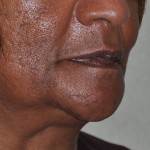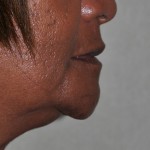The chin is a portion of the jaw bone that not only juts outward but is also enveloped by soft tissue attachments. The mentalis muscle is one of the dominant muscles of the chin. It is a paired central muscle which has a significant effect on the lower lip. It has fibers which attach below the mandibular vestibule, known as the incisive fossa of the mandible, and then descends vertically downward to insert into the skin of the skin. It is a muscle of facial expression as it raises and pushes up the lower lip and causes wrinkling of the chin, making a pout.
While this facial expression function seems rather trivial, if the mentalis muscle loses it bony attachments one will have something to pout about. This is an unfortunate occurrence that occur from intraoral chin procedures and, most commonly, after a chin implant has been removed or from multiple chin surgeries. When the mentalis muscle loses its superior bony anchoring point, the entire chin soft tissue pad can droop. This has a classic name which well defines its appearance, known as a ‘witch’s chin’, with the chin pad falling off of the end of the bone.
The correction of the witch’s chin deformity has been well described with the mainstay treatment approach of mentalis muscle resuspension. Multiple methods of how to fix the muscle to the chin bone have been described. While it is a relatively straightforward procedure from a technical standpoint, getting a stable result with tight tissue adaptation across the convex chin is not always easy or successful.
While the common origin of a witch’s chin is chin implant surgery, many older patients who have never had chin surgery have it. It is actually exceedingly common and everyone has seen someone with it. It is the result of a natural process that largely affects older individual’s tooth loss.

The edentulous witch’s chin deformity is the result of a natural aging process rather than one caused by surgery and cosmetic manipulation. It can be successfully treated by removing the loose hanging tissues rather than muscle resuspension.
Dr. Barry Eppley
Indianapolis, Indiana



